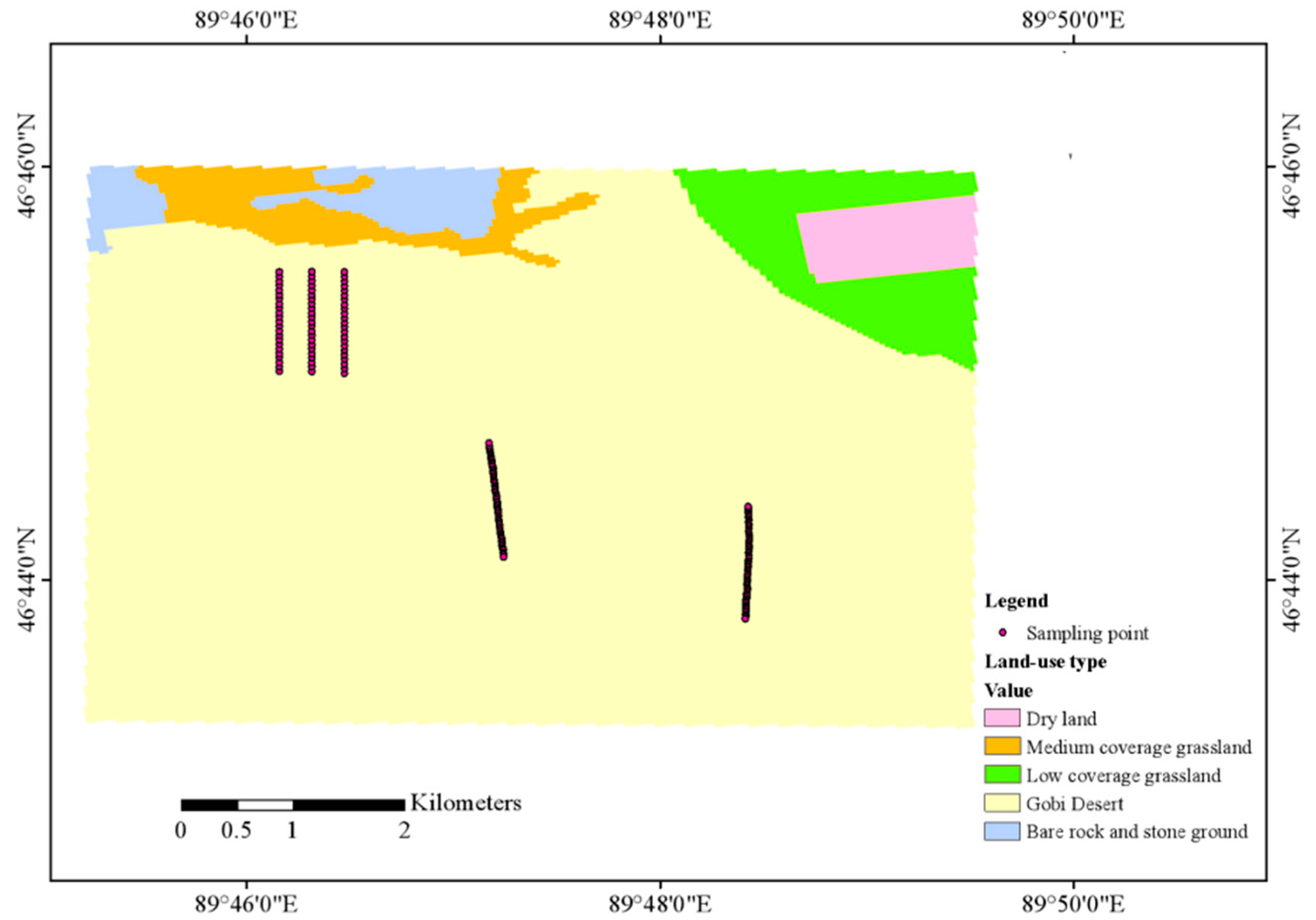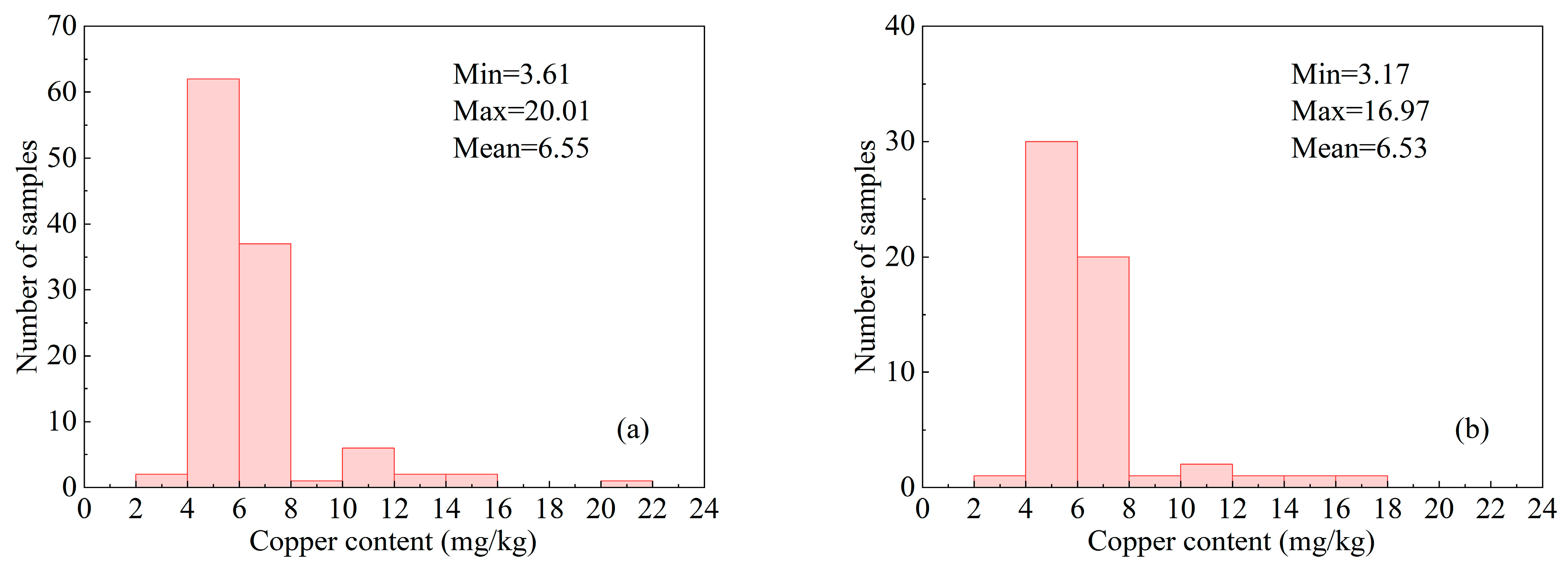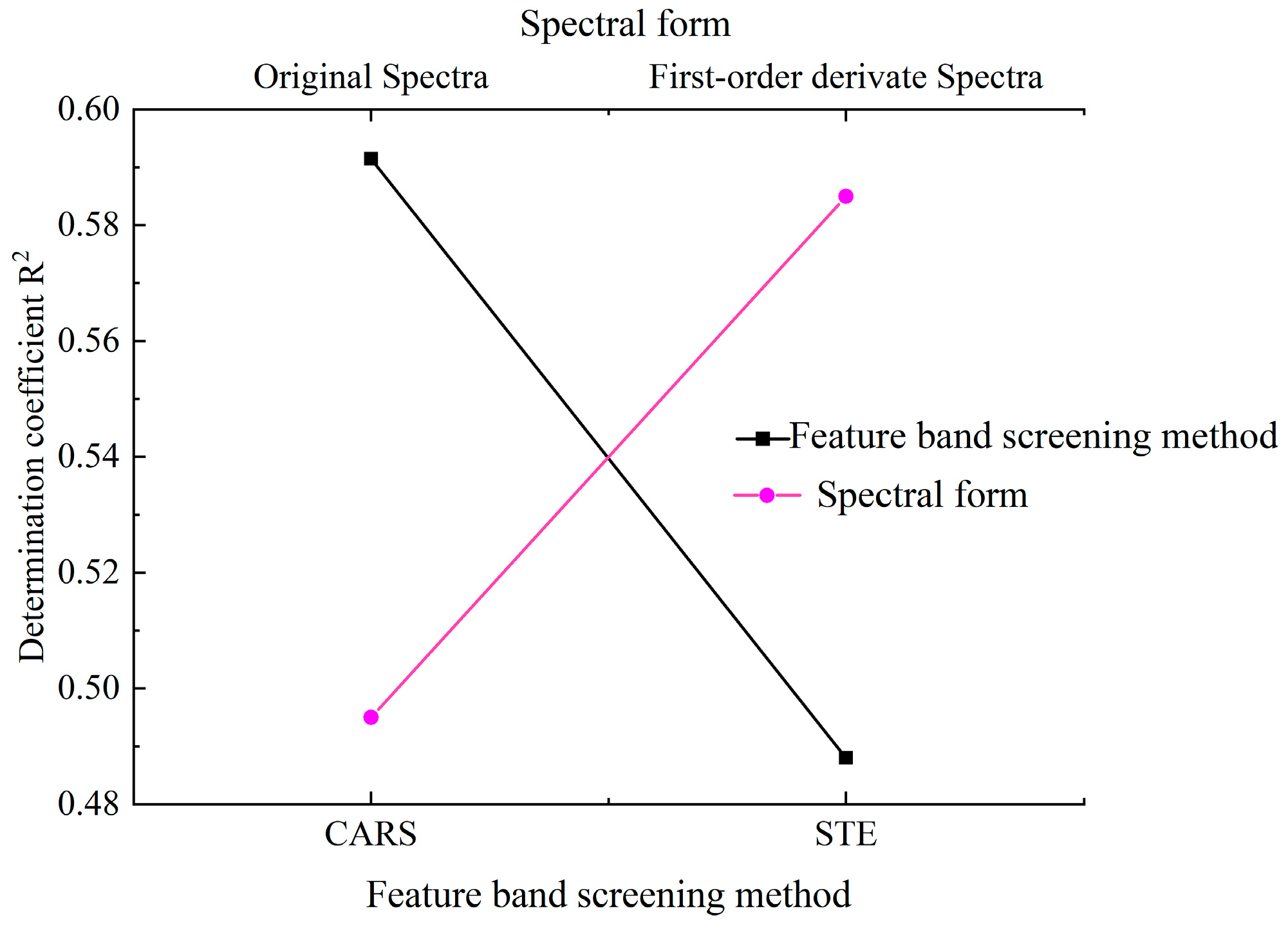A Rapid Intelligent Screening of a Three-Band Index for Estimating Soil Copper Content
Abstract
1. Introduction
2. Materials and Methods
2.1. Research Area and Sampling Design
2.2. Soil Spectral Measurement
2.3. Feature Band Screening Method
2.4. Development of a Three-Band Spectral Index
2.5. Estimation Model Construction and Evaluation
3. Results
3.1. Analysis of Copper Concentration in Soil Samples
3.2. Statistical Analysis of Selected Feature Bands
3.3. Optimal Three-Band Spectral Index
3.4. Comparative Analysis of Models for Estimating Soil Copper Content
4. Discussion
5. Conclusions
Author Contributions
Funding
Institutional Review Board Statement
Informed Consent Statement
Data Availability Statement
Conflicts of Interest
References
- Maung, K.N.; Hashimoto, S.; Mizukami, M.; Morozumi, M.; Lwin, C.M. Assessment of the Secondary Copper Reserves of Nations. Environ. Sci. Technol. 2017, 51, 3824–3832. [Google Scholar] [CrossRef]
- Kang, X.Y.; Wang, M.X.; Wang, T.X.; Luo, F.J.; Lin, J.; Li, X. Trade trends and competition intensity of international copper flow based on complex network: From the perspective of industry chain. Resour. Policy 2022, 79, 103060. [Google Scholar] [CrossRef]
- Wang, J.B.; Zheng, S.X.; Liu, W.; Chen, L.; Wen, Z.G.; Li, X. Prediction, evaluation and optimization of China’s copper resource supply system under carbon constraints. Sustain. Prod. Consum. 2023, 39, 285–300. [Google Scholar] [CrossRef]
- Eskdale, A.; Johnson, S.C.; Gough, A. The applicability of G-BASE stream sediment geochemistry as a combined geological mapping, and prospective exploration tool for As-Co-Cu-Ni mineralisation across Cumbria, UK. J. Geochem. Explor. 2023, 253, 107297. [Google Scholar] [CrossRef]
- Martín-Méndez, I.; Borrajo, J.L.; Bel-lan, A.; Locutura, J. Geochemical distribution in residual soils of Iberian Pyrite Belt (Spain). J. Iber. Geol. 2023, 49, 97–114. [Google Scholar] [CrossRef]
- Ribeiro, B.O.L.; Barbuena, D.; de Melo, G.H.C. Geochemical multifractal modeling of soil and stream sediment data applied to gold prospectivity mapping of the Pitangui Greenstone Belt, northwest of Brazil. Geochemistry 2023, 83, 125951. [Google Scholar] [CrossRef]
- Henne, A.; Noble, R.R.P.; Williams, M. Multi-element geochemical analyses on ultrafine soils in Western Australia—Towards establishing abundance ranges in mineral exploration settings. Geochem.-Explor. Environ. Anal. 2024, 24, 2023043. [Google Scholar] [CrossRef]
- Noble, R.R.P.; Henne, A.; Stromberg, J.; Lau, I.C.; Pejcic, B.; Pinchand, G.T. The effect of biosecurity heat treatment on soils: Implications for soil analytical methods and mineral exploration. Geochem.-Explor. Environ. Anal. 2024, 24, 2024017. [Google Scholar] [CrossRef]
- Vural, A. Soil geochemistry survey for gold exploration at Kısacık area (Çanakkale, Ayvacık, Turkiye). Period. Miner. 2024, 93, 18335. [Google Scholar]
- Barak, S.; Imamalipour, A.; Abedi, M. Employing multiple prospectivity mapping and exploration targeting, a case study from the Sonajil porphyry copper deposit, north-western Iran. Bull. Geophys. Oceanogr. 2024, 65, 715–740. [Google Scholar]
- Chitalin, A.F.; Baksheev, I.A.; Nikolaev, Y.N. Porphyry Copper and Epithermal Gold-Silver Mineralization of the Baimka Ore Zone, Western Chukotka, Russia. Geol. Ore Depos. 2024, 66, 21–41. [Google Scholar] [CrossRef]
- Habashi, J.; Moghadam, H.J.; Oskouei, M.M.; Pour, A.B.; Hashim, M. PRISMA Hyperspectral Remote Sensing Data for Mapping Alteration Minerals in Sar-e-Châh-e-Shur Region, Birjand, Iran. Remote Sens. 2024, 16, 1277. [Google Scholar] [CrossRef]
- Makshakov, A.S.; Kravtsova, R.G. Features of sampling stream sediments of large river valleys under cryolithogenesis conditions in the Balygychan-Sugoy trough, North-East of Russia. Acta Geochim. 2024, 43, 638–660. [Google Scholar] [CrossRef]
- Hopfner, M.; Brönner, M.; Carter, L.; Nazari-Dehkordi, T.; Menuge, J.; Müller, A.; Williamson, B. Vectoring towards buried high-purity quartz metapegmatites using low-elevation radiometric and soil geochemical surveying: Method validation in Tysfjord, Norway. J. Geochem. Explor. 2025, 270, 107667. [Google Scholar] [CrossRef]
- Arif, M.; Qi, Y.C.; Dong, Z.; Wei, H. Rapid retrieval of cadmium and lead content from urban greenbelt zones using hyperspectral characteristic bands. J. Clean. Prod. 2022, 374, 133922. [Google Scholar] [CrossRef]
- Saha, A.; Sen Gupta, B.; Patidar, S.; Martinez-Villegas, N. Identification of Soil Arsenic Contamination in Rice Paddy Field Based on Hyperspectral Reflectance Approach. Soil. Syst. 2022, 6, 30. [Google Scholar] [CrossRef]
- Wang, Y.; Abliz, A.; Ma, H.B.; Liu, L.; Kurban, A.; Halik, Ü.; Pietikäinen, M.; Wang, W.J. Hyperspectral Estimation of Soil Copper Concentration Based on Improved TabNet Model in the Eastern Junggar Coalfield. IEEE Trans. Geosci. Remote 2022, 60, 5534020. [Google Scholar] [CrossRef]
- Tan, K.; Chen, L.H.; Wang, H.M.; Liu, Z.X.; Ding, J.W.; Wang, X. Estimation of the distribution patterns of heavy metal in soil from airborne hyperspectral imagery based on spectral absorption characteristics. J. Environ. Manag. 2023, 347, 119196. [Google Scholar] [CrossRef]
- Yang, K.; Wu, F.; Guo, H.X.; Chen, D.B.; Deng, Y.R.; Huang, Z.Q.; Han, C.L.; Chen, Z.L.; Xiao, R.B.; Chen, P.C. Hyperspectral Inversion of Soil Cu Content in Agricultural Land Based on Continuous Wavelet Transform and Stacking Ensemble Learning. Land 2024, 13, 1810. [Google Scholar] [CrossRef]
- Chen, Y.A.; Shi, W.Y.; Aihemaitijiang, G.; Zhang, F.; Zhang, J.Q.; Zhang, Y.C.; Pan, D.Q.; Liu, J.Y. Hyperspectral inversion of heavy metal content in farmland soil under conservation tillage of black soils. Sci. Rep. 2025, 15, 354. [Google Scholar] [CrossRef]
- Zhang, H.; Zhang, N.N.; Liao, S.B.; Liu, C.; Chen, L.; Chang, J.Y.; Tao, J.T. Reflectance spectroscopy analysis and lithium content estimation in lithium-rich rocks and stream sediments: Insights from Tuanjie Peak, Western Kunlun, China. Spectrochim. Acta A 2025, 324, 125010. [Google Scholar] [CrossRef] [PubMed]
- Chen, L.H.; Lai, J.; Tan, K.; Wang, X.; Chen, Y.; Ding, J.W. Development of a soil heavy metal estimation method based on a spectral index: Combining fractional-order derivative pretreatment and the absorption mechanism. Sci. Total Environ. 2022, 813, 151882. [Google Scholar] [CrossRef]
- Fu, P.J.; Yang, K.M.; Meng, F.; Zhang, W.; Cui, Y.; Feng, F.S.; Yao, A.G.B. A new three-band spectral and metal element index for estimating soil arsenic content around the mining area. Process Saf. Environ. 2022, 157, 27–36. [Google Scholar] [CrossRef]
- Fu, P.J.; Zhang, J.W.; Yuan, Z.X.; Feng, J.F.; Zhang, Y.X.; Meng, F.; Zhou, S.B. Estimating the Heavy Metal Contents in Entisols from a Mining Area Based on Improved Spectral Indices and Catboost. Sensors 2024, 24, 1492. [Google Scholar] [CrossRef]
- Jiang, G.; Chen, X.; Wang, J.L.; Wang, S.S.; Zhou, S.G.; Bai, Y.; Liao, T.; Yang, K.; Ma, K.; Fan, X.L. Estimation of the Multielement Content in Rocks Based on a Combination of Visible-Near-Infrared Reflectance Spectroscopy and Band Index Analysis. Remote Sens. 2023, 15, 3591. [Google Scholar] [CrossRef]
- Meng, C.; Hong, M.; Hu, Y.C.; Li, F. Using Optimized Spectral Indices and Machine Learning Algorithms to Assess Soil Copper Concentration in Mining Areas. Sustainability 2024, 16, 4153. [Google Scholar] [CrossRef]
- Ouyang, H.K.; Tang, L.L.; Ma, J.L.; Pang, T. Application of Hyperspectral Technology with Machine Learning for Brix Detection of Pastry Pears. Plants 2024, 13, 1163. [Google Scholar] [CrossRef]
- Wu, R.H.; Fan, Y.Q.; Zhang, L.Y.; Yuan, D.B.; Gao, G.T. Wheat Yield Estimation Study Using Hyperspectral Vegetation Indices. Appl. Sci. 2024, 14, 4245. [Google Scholar] [CrossRef]
- Sawut, M.; Hu, X.; Manlike, A.; Aimaier, A.; Cui, J.T.; Liang, J.X. Enhancing Leaf Area Index Estimation in Southern Xinjiang Fruit Trees: A Competitive Adaptive Reweighted Sampling-Successive Projections Algorithm and Three-Band Index Approach with Fractional-Order Differentiation. Forests 2025, 15, 2126. [Google Scholar] [CrossRef]
- Adesokan, M.; Otegbayo, B.; Alamu, E.O.; Olutoyin, M.A.; Maziya-Dixon, B. Evaluating the dry matter content of raw yams using hyperspectral imaging spectroscopy and machine learning. J. Food Compos. Anal. 2025, 135, 106692. [Google Scholar] [CrossRef]
- Wei, L.F.; Pu, H.C.; Wang, Z.X.; Yuan, Z.R.; Yan, X.R.; Cao, L.Q. Estimation of Soil Arsenic Content with Hyperspectral Remote Sensing. Sensors 2020, 20, 4056. [Google Scholar] [CrossRef]
- Almeida, L.; Rocha, F.; Candeias, C. Geochemical and mineralogical characterization of Ria de Aveiro (Portugal) saltpan sediments for pelotherapy application. Environ. Geochem. Health 2023, 45, 3199–3214. [Google Scholar] [CrossRef]
- Feng, X.Q.; Tian, A.H.; Fu, C.B. Hyperspectral prediction model of soil Cu content based on WOA-SPA algorithm. Int. J. Remote Sens. 2024, 45, 6408–6424. [Google Scholar] [CrossRef]
- Jia, Y.N.; Gan, D.Q.; Bai, Y.; Wang, J.H.; Dong, Y.; Wang, Y.J. Hyperspectral Inversion of Chromium Content in Soils of the Tangshan Iron Tailings Area. Pol. J. Environ. Stud. 2024, 33, 4997–5001. [Google Scholar] [CrossRef]
- Aneece, I.; Epstein, H. Distinguishing Early Successional Plant Communities Using Ground-Level Hyperspectral Data. Remote Sens. 2015, 7, 16588–16606. [Google Scholar] [CrossRef]
- Richter, R.; Reu, B.; Wirth, C.; Doktor, D.; Vohland, M. The use of airborne hyperspectral data for tree species classification in a species-rich Central European forest area. Int. J. Appl. Earth Obs. 2016, 52, 464–474. [Google Scholar] [CrossRef]
- Tan, K.; Ma, W.B.; Chen, L.H.; Wang, H.M.; Du, Q.; Du, P.J.; Yan, B.K.; Liu, R.Y.; Li, H.D. Estimating the distribution trend of soil heavy metals in mining area from HyMap airborne hyperspectral imagery based on ensemble learning. J. Hazard. Mater. 2021, 401, 123288. [Google Scholar] [CrossRef] [PubMed]
- Wen, L.; Ling, H.; Ming, L.; Li, L.Z. Inversion of Cd Content in Soil Around Mining Area Based on GaoFen-5 Hyperspectral Band Selection. Laser Optoelectron. Prog. 2023, 60, 1728001. [Google Scholar]
- Zhang, Y.X.; Wei, L.F.; Lu, Q.K.; Zhong, Y.F.; Yuan, Z.R.; Wang, Z.X.; Li, Z.Q.; Yang, Y.J. Mapping soil available copper content in the mine tailings pond with combined simulated annealing deep neural network and UAV hyperspectral images. Environ. Pollut. 2023, 320, 120962. [Google Scholar] [CrossRef] [PubMed]
- Shi, T.Z.; Liu, H.Z.; Wang, J.J.; Chen, Y.Y.; Fei, T.; Wu, G.F. Monitoring Arsenic Contamination in Agricultural Soils with Reflectance Spectroscopy of Rice Plants. Environ. Sci. Technol. 2014, 48, 6264–6272. [Google Scholar] [CrossRef]
- Wang, F.; Wang, J.N.; Cao, W.T.; Kang, R.F.; Cao, J.F.; Wu, Q.Y. Concentration Estimation of Heavy Metal Cr in Soils from Jiaojia-Type Gold Mining Areas Using Reflectance Spectroscopy. Spectrosc. Spect. Anal. 2017, 37, 1651–1657. [Google Scholar]
- Hong, Y.S.; Shen, R.L.; Chen, H.; Chen, Y.Y.; Zhang, Y.; Liu, Y.L.; Zhou, M.; Yu, L.; Liu, Y.F. Estimating lead and zinc concentrations in peri-urban agricultural soils through reflectance spectroscopy: Effects of fractional-order derivative and random forest. Sci. Total Environ. 2019, 651, 1969–1982. [Google Scholar] [CrossRef] [PubMed]
- Wang, X.; An, S.; Xu, Y.Q.; Hou, H.P.; Chen, F.Y.; Yang, Y.J.; Zhang, S.L.; Liu, R. A Back Propagation Neural Network Model Optimized by Mind Evolutionary Algorithm for Estimating Cd, Cr, and Pb Concentrations in Soils Using Vis-NIR Diffuse Reflectance Spectroscopy. Appl. Sci. 2020, 10, 51. [Google Scholar] [CrossRef]
- Zhang, Z.L.; Wang, Z.; Luo, Y.; Zhang, J.Q.; Feng, X.Y.; Tian, D.; Li, C.; Zhang, Y.D.; Wang, Y.P. Quantitative Analysis of Soil Cd Content Based on the Fusion of Vis-NIR and XRF Spectral Data in the Impacted Area of a Metallurgical Slag Site in Gejiu, Yunnan. Processes 2023, 11, 2714. [Google Scholar] [CrossRef]







| Name of Spectral Index | Calculation Formula |
|---|---|
| TVI-1 | (S1 − S2)/S3 |
| TVI-2 | (S2 + S3)/S1 |
| TVI-3 | (S1 − S2)/(S3 − S2) |
| Spectral Type | Screening Method | Number of Bands | Position of Bands (nm) |
|---|---|---|---|
| Original spectrum | CARS | 26 | 404.5, 674.5, 734.5, 774.5, 784.5, 824.5, 1164.5, 1194.5, 1204.5, 1214.5, 1224.5, 1264.5, 1274.5, 1417.5, 2155.5, 2165.5, 2175.5, 2185.5, 2215.5, 2225.5, 2305.5, 2315.5, 2325.5, 2335.5, 2345.5, 2395.5 |
| Original spectrum | STE | 13 | 434.5, 444.5, 454.5, 464.5, 564.5, 604.5, 1014.5, 1034.5, 1094.5, 1194.5, 1214.5, 1294.5, 1417.5 |
| First-order derivative spectrum | CARS | 12 | 434.5, 604.5, 804.5, 884.5, 914.5, 1024.5, 1447.5, 1647.5, 2155.5, 2235.5, 2275.5, 2365.5 |
| First-order derivative spectrum | STE | 5 | 634.5, 724.5, 1024.5, 2305.5, 2365.5 |
| Spectral Type | Screening Method | Spectral Index Type | Determination Coefficient R2 |
|---|---|---|---|
| Original spectrum | CARS | TVI-1 | 0.6093 |
| Original spectrum | CARS | TVI-2 | 0.6087 |
| Original spectrum | CARS | TVI-3 | 0.6209 |
| Original spectrum | STE | TVI-1 | 0.3752 |
| Original spectrum | STE | TVI-2 | 0.3915 |
| Original spectrum | STE | TVI-3 | 0.5717 |
| First-order derivative spectrum | CARS | TVI-1 | 0.7514 |
| First-order derivative spectrum | CARS | TVI-2 | 0.7651 |
| First-order derivative spectrum | CARS | TVI-3 | 0.5910 |
| First-order derivative spectrum | STE | TVI-1 | 0.7592 |
| First-order derivative spectrum | STE | TVI-2 | 0.7654 |
| First-order derivative spectrum | STE | TVI-3 | 0.5257 |
Disclaimer/Publisher’s Note: The statements, opinions and data contained in all publications are solely those of the individual author(s) and contributor(s) and not of MDPI and/or the editor(s). MDPI and/or the editor(s) disclaim responsibility for any injury to people or property resulting from any ideas, methods, instructions or products referred to in the content. |
© 2025 by the authors. Licensee MDPI, Basel, Switzerland. This article is an open access article distributed under the terms and conditions of the Creative Commons Attribution (CC BY) license (https://creativecommons.org/licenses/by/4.0/).
Share and Cite
Liu, S.; Cui, S.; Wang, R.; Han, M.; Kou, J. A Rapid Intelligent Screening of a Three-Band Index for Estimating Soil Copper Content. Molecules 2025, 30, 3215. https://doi.org/10.3390/molecules30153215
Liu S, Cui S, Wang R, Han M, Kou J. A Rapid Intelligent Screening of a Three-Band Index for Estimating Soil Copper Content. Molecules. 2025; 30(15):3215. https://doi.org/10.3390/molecules30153215
Chicago/Turabian StyleLiu, Shiyao, Shichao Cui, Rengui Wang, Minming Han, and Jingtao Kou. 2025. "A Rapid Intelligent Screening of a Three-Band Index for Estimating Soil Copper Content" Molecules 30, no. 15: 3215. https://doi.org/10.3390/molecules30153215
APA StyleLiu, S., Cui, S., Wang, R., Han, M., & Kou, J. (2025). A Rapid Intelligent Screening of a Three-Band Index for Estimating Soil Copper Content. Molecules, 30(15), 3215. https://doi.org/10.3390/molecules30153215





